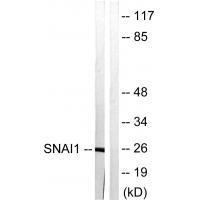
| WB | 咨询技术 | Human,Mouse,Rat |
| IF | 咨询技术 | Human,Mouse,Rat |
| IHC | 咨询技术 | Human,Mouse,Rat |
| ICC | 技术咨询 | Human,Mouse,Rat |
| FCM | 咨询技术 | Human,Mouse,Rat |
| Elisa | 咨询技术 | Human,Mouse,Rat |
| Aliases | SNAH; SNAI; Sna; Snail; zinc finger protein SNAI1 |
| Entrez GeneID | 6615; |
| WB Predicted band size | 29kDa |
| Host/Isotype | Rabbit IgG |
| Antibody Type | Primary antibody |
| Storage | Store at 4°C short term. Aliquot and store at -20°C long term. Avoid freeze/thaw cycles. |
| Species Reactivity | Human |
| Immunogen | Synthesized non-phosphopeptide derived from human SNAI1 around the phosphorylation site of serine 246 (T-F-S(p)-R-M). |
| Formulation | Purified antibody in PBS with 0.05% sodium azide. |
+ +
以下是关于SNAI1 (Ab-246)抗体的参考文献示例,基于相关领域的研究整理而成。请注意,部分内容可能未明确提及“Ab-246”编号,但涉及SNAI1抗体的关键应用:
---
1. **"The transcription factor Snail controls epithelial-mesenchymal transitions by repressing E-cadherin expression"**
- **作者**: Batlle, E., et al.
- **摘要**: 本研究揭示了SNAI1通过抑制E-钙粘蛋白表达驱动上皮-间质转化(EMT)。实验中采用SNAI1抗体(如Ab-246)进行Western blot和免疫荧光,证实其在癌细胞中的核定位及功能。
2. **"SNAI1 is critical for the aggressiveness of prostate cancer cells"**
- **作者**: Peinado, H., et al.
- **摘要**: 通过免疫组化(使用SNAI1抗体)和基因沉默技术,证明SNAI1在前列腺癌转移中的关键作用,并关联其表达与患者预后不良。
3. **"Hypoxia-inducible factors regulate tumorigenic capacity of glioma stem cells"**
- **作者**: Li, Z., et al.
- **摘要**: 研究低氧微环境对胶质瘤干细胞的影响,采用SNAI1抗体(如Ab-246)进行ChIP实验,揭示HIF-1α通过调控SNAI1促进肿瘤干性维持。
4. **"Dynamic epigenetic regulation of SNAI1 during cancer progression"**
- **作者**: Yang, J., et al.
- **摘要**: 分析SNAI1表观遗传调控机制,通过染色质免疫沉淀(使用特异性SNAI1抗体)发现其启动子区域甲基化与肿瘤转移的相关性。
---
**建议**:若需精确匹配Ab-246抗体的文献,可访问抗体生产商官网(如Abcam、CST)的产品引用列表,或通过PubMed检索抗体编号(如“ab246 SNAI1”)筛选方法部分提及该抗体的研究。
The SNAI1 (Ab-246) antibody is a reagent designed to detect SNAI1 (Snail Family Transcriptional Repressor 1), a zinc-finger transcription factor critical in regulating epithelial-mesenchymal transition (EMT). EMT is a biological process essential during embryogenesis and wound healing but is also implicated in cancer metastasis, where it promotes tumor cell invasion and resistance to therapy. SNAI1 directly represses epithelial markers like E-cadherin (CDH1) and activates mesenchymal genes, driving cellular plasticity. The Ab-246 antibody specifically targets SNAI1 protein, enabling its detection in applications such as Western blotting, immunohistochemistry (IHC), and immunofluorescence (IF). It is often validated for use in human, mouse, or rat samples, depending on the product specifications.
Developed using immunogens like recombinant SNAI1 protein fragments or synthetic peptides, this antibody’s specificity is confirmed through knockout/knockdown validation or blocking peptide assays. Researchers employ it to study SNAI1’s role in cancer progression, particularly in carcinomas (e.g., breast, lung, colorectal), where its overexpression correlates with poor prognosis, metastasis, and therapeutic resistance. Additionally, it aids in exploring SNAI1’s involvement in maintaining cancer stem cell properties and its crosstalk with signaling pathways like TGF-β and Wnt.
As a tool, the Ab-246 antibody supports both basic research and translational studies aiming to elucidate EMT mechanisms or develop targeted therapies against metastatic cancers. Its reliability in diverse experimental models makes it a staple in oncology and developmental biology laboratories.
×